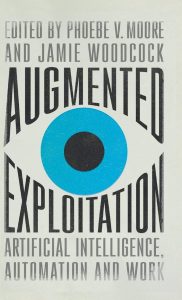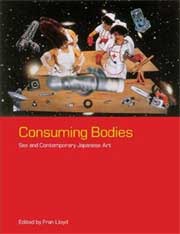 Consuming Bodies: Sex and Contemporary Japanese Art, edited by Fran Lloyd (Amazon USA
Consuming Bodies: Sex and Contemporary Japanese Art, edited by Fran Lloyd (Amazon USA

Editor Reaktion Books says: Consuming Bodies explores the themes of sex and consumerism in contemporary Japanese art and how they connect with the wider historical, social and political conditions in Japanese culture. Essays by writers, historians, curators and artists, plus diary extracts of a sex worker, engage with a range of artistic practices, including performance, digital media, painting, sculpture and installation. Together the contributors examine the contradictions and ambivalences embedded in the Japanese experience of modernity, and the effects of commodification on the individual and the nation state.
The list of contributors features a nice mix of Japanese and Western authors, artists, journalists, researchers, curators and academics.
As the introduction points out, despite Japan prime presence on the global marketplace, Western audiences are still fairly unfamiliar with the Japanese contemporary art scene. The book has been written in 2002 and 5 years on, the statement is still true. Proof is that finding images online of some of the artists mentioned in the book has been hard work.
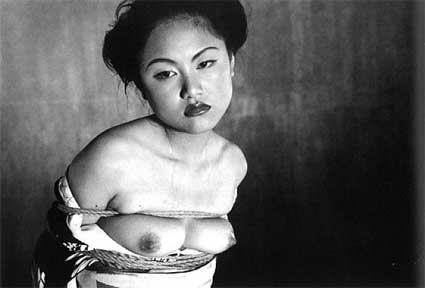 Araki Nobuyoshi, Personal Sentimentalism in Photography
Araki Nobuyoshi, Personal Sentimentalism in Photography
A precious characteristic of the essays is that its authors do not isolate art and analyse or comment on it for its own sake but they also take into account the historical and material circumstances which have conditioned the emergence of contemporary Japanese art. besides the account of the imaging of sex and consumerism moves beyond the glamour, exotic and amusing aspects of Japanese behaviours and explores with much finesse the balance between the private and public aspects of sexual activities as found in media, comics, departments stores, etc.
 Miwa Yanagi, Eternal City I
Miwa Yanagi, Eternal City I
Of course the book provides you with that Japanese quirkiness we like so much. I learned about Soaplands (a type of brothel where “client” can be bathed with female “companion”), Pink Salons (a brothel which specialises in oral sex); Compensated dating (the euphemism that usually refers to the practice of high school-age girls being paid by older men to accompany them on dates enabling the girls to get the lifestyle they crave for) which doesn´t carry the same evil connotations as in Western countries, women´s attitude towards sex and prostitution is different in Japan as it is not necessarily regarded as degrading in itself.
I also discovered the inevitable dark sides of sex, consumption and art such as the strong gender division, illegal human trafficking and how different the art system in Japan is from ours, from school to art galleries.
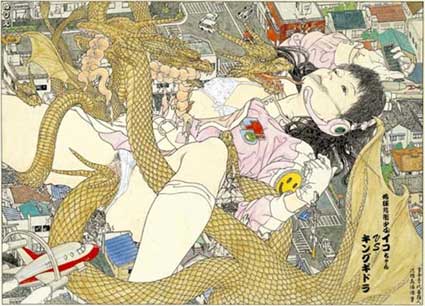 Makoto Aida, The member of the giant Ico Chan vs. King Gidora
Makoto Aida, The member of the giant Ico Chan vs. King Gidora
Chapter 1 and 2 give an historical perspective on sex and consumerism from the Edo period until today. The three following chapters focus on the work of contemporary artists who reached their artistic maturity during the height of the bubble economy in the late ’80s. Chapter 4 in particular is a montage of images performed by Bubu and Yoshiko Shimada; titled Made in Occupied Japan, the work recalls the experiences of US GIs in Japan, prostitution, and Japanese housewives. Chapter 5 is all about the cult of kawaii and how it came into being. Chapter 6 explores the work of Makoto Aida. Chapter 7 Tokyo´s Urban and Sexual Transformations: Performance Art and Digital Cultures is mostly about performances and theatre, not much about digital anything.
It is interesting to be reminded that when Japan opened its borders, art and craftmanship were so indistinguishable that the language had no word for “art”, they had to invent Hijutsu which means “technique of beauty”. This has several consequences on contemporary art in Japan, one of them being that there is absolutely no stigma attached to being an artist sponsored by commercial companies.
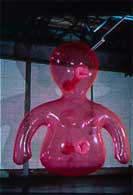
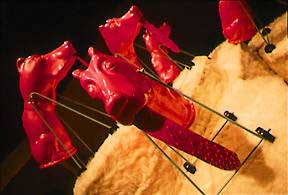 Immunity to pleasure – Balloon, 1993 and For Pleasure! – Dogs, 1995
Immunity to pleasure – Balloon, 1993 and For Pleasure! – Dogs, 1995
The representation of sex in Japanese art often comes with a high dosis of dissent. Nothing new except that the formula is now adopted by many women artists eager to trash the confucianist idea that they have to be demure and submissive creatures.
Sex in itself is actually not enough to shock, the Japanese do not carry the burden of Christian guilt. For the more austere Samurai rulers, licentiousness was more the stuff of self-indulgence and weakness but not necessarily more than other forms of entertainments. That might explain why today bars, pachinko parlours, discos, game centres and sexual entertainment all come under the Law for the Regulation of Business Affecting Public Morals (1947). Another noteworthy peculiarity of the nation´s laws is that showing pubic hair was forbidden until 1981 when the government officially allowed for the appearance of 5% amount of pubic hair in photographs.
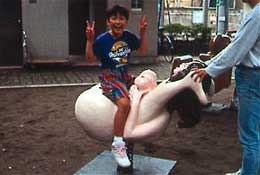 The work of Takahiro Fujiwara embodies quite well the ambivalent attitude towards sex. Fujiwara specializes in kitschy sculptures that look like big sex toys. There´s this naked women lying on her back with open legs (which reminds Allen Jones´ furniture) which he presented in a kids´playground as a kind of hobby horse. No one found it particularly obscene. The artist believes that one could only do such thing in Japan, albeit under certain conditions. Fujiwara explains. “Sex is something everyone is interested in, but using real experience is too physical, so by using something like a sexual toy which does not refer to one´s life and body but which is cute, one can get away with dealing with a taboo…”
The work of Takahiro Fujiwara embodies quite well the ambivalent attitude towards sex. Fujiwara specializes in kitschy sculptures that look like big sex toys. There´s this naked women lying on her back with open legs (which reminds Allen Jones´ furniture) which he presented in a kids´playground as a kind of hobby horse. No one found it particularly obscene. The artist believes that one could only do such thing in Japan, albeit under certain conditions. Fujiwara explains. “Sex is something everyone is interested in, but using real experience is too physical, so by using something like a sexual toy which does not refer to one´s life and body but which is cute, one can get away with dealing with a taboo…”
I loved BuBu´s Dairy, the final chapter of the book. BuBu is both an artist and a sex worker and she wrote about her daily life: who her clients are, which kind of present they offer her (from potatoes to pastries and lottery tickets), the way her 80 year old client makes love, nightmare, etc.





